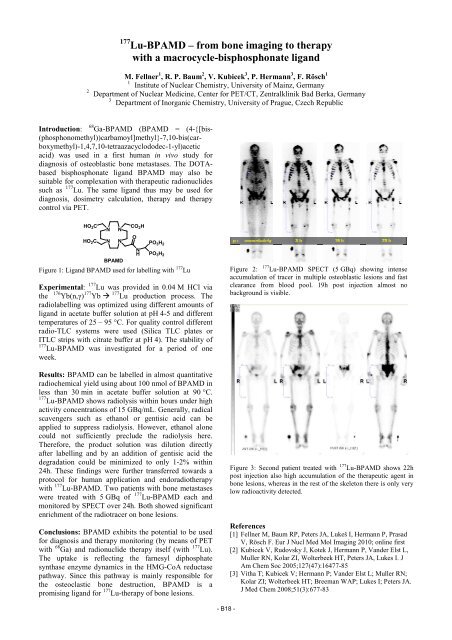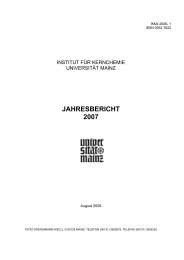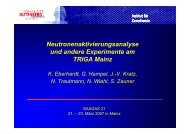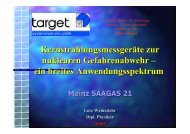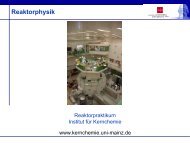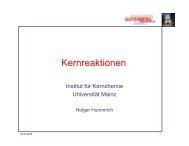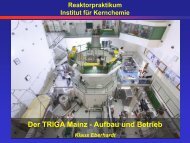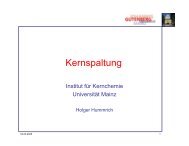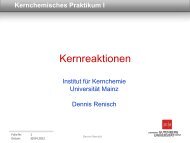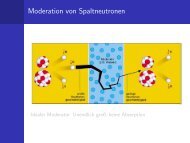institut für kernchemie universität mainz jahresbericht 2009
institut für kernchemie universität mainz jahresbericht 2009
institut für kernchemie universität mainz jahresbericht 2009
Create successful ePaper yourself
Turn your PDF publications into a flip-book with our unique Google optimized e-Paper software.
177 Lu-BPAMD – from bone imaging to therapy<br />
with a macrocycle-bisphosphonate ligand<br />
M. Fellner 1 , R. P. Baum 2 , V. Kubicek 3 , P. Hermann 3 , F. Rösch 1<br />
1 Institute of Nuclear Chemistry, University of Mainz, Germany<br />
2 Department of Nuclear Medicine, Center for PET/CT, Zentralklinik Bad Berka, Germany<br />
3 Department of Inorganic Chemistry, University of Prague, Czech Republic<br />
Introduction: 68 Ga-BPAMD (BPAMD = (4-{[bis-<br />
(phosphonomethyl))carbamoyl]methyl}-7,10-bis(carboxymethyl)-1,4,7,10-tetraazacyclododec-1-yl)acetic<br />
acid) was used in a first human in vivo study for<br />
diagnosis of osteoblastic bone metastases. The DOTAbased<br />
bisphosphonate ligand BPAMD may also be<br />
suitable for complexation with therapeutic radionuclides<br />
such as 177 Lu. The same ligand thus may be used for<br />
diagnosis, dosimetry calculation, therapy and therapy<br />
control via PET.<br />
HO 2C<br />
HO 2C<br />
N N<br />
N<br />
N<br />
BPAMD<br />
CO 2H<br />
O<br />
N<br />
H<br />
PO 3H 2<br />
PO 3H 2<br />
Figure 1: Ligand BPAMD used for labelling with 177 Lu<br />
Experimental: 177 Lu was provided in 0.04 M HCl via<br />
the 176 Yb(n,γ) 177 Yb � 177 Lu production process. The<br />
radiolabelling was optimized using different amounts of<br />
ligand in acetate buffer solution at pH 4-5 and different<br />
temperatures of 25 – 95 °C. For quality control different<br />
radio-TLC systems were used (Silica TLC plates or<br />
ITLC strips with citrate buffer at pH 4). The stability of<br />
177 Lu-BPAMD was investigated for a period of one<br />
week.<br />
Results: BPAMD can be labelled in almost quantitative<br />
radiochemical yield using about 100 nmol of BPAMD in<br />
less than 30 min in acetate buffer solution at 90 °C.<br />
177 Lu-BPAMD shows radiolysis within hours under high<br />
activity concentrations of 15 GBq/mL. Generally, radical<br />
scavengers such as ethanol or gentisic acid can be<br />
applied to suppress radiolysis. However, ethanol alone<br />
could not sufficiently preclude the radiolysis here.<br />
Therefore, the product solution was dilution directly<br />
after labelling and by an addition of gentisic acid the<br />
degradation could be minimized to only 1-2% within<br />
24h. These findings were further transferred towards a<br />
protocol for human application and endoradiotherapy<br />
with 177 Lu-BPAMD. Two patients with bone metastases<br />
were treated with 5 GBq of 177 Lu-BPAMD each and<br />
monitored by SPECT over 24h. Both showed significant<br />
enrichment of the radiotracer on bone lesions.<br />
Conclusions: BPAMD exhibits the potential to be used<br />
for diagnosis and therapy monitoring (by means of PET<br />
with 68 Ga) and radionuclide therapy itself (with 177 Lu).<br />
The uptake is reflecting the farnesyl diphosphate<br />
synthase enzyme dynamics in the HMG-CoA reductase<br />
pathway. Since this pathway is mainly responsible for<br />
the osteoclastic bone destruction, BPAMD is a<br />
promising ligand for 177 Lu-therapy of bone lesions.<br />
- B18 -<br />
Figure 2: 177 Lu-BPAMD SPECT (5 GBq) showing intense<br />
accumulation of tracer in multiple osteoblastic lesions and fast<br />
clearance from blood pool. 19h post injection almost no<br />
background is visible.<br />
Figure 3: Second patient treated with 177 Lu-BPAMD shows 22h<br />
post injection also high accumulation of the therapeutic agent in<br />
bone lesions, whereas in the rest of the skeleton there is only very<br />
low radioactivity detected.<br />
References<br />
[1] Fellner M, Baum RP, Peters JA, Lukeš I, Hermann P, Prasad<br />
V, Rösch F. Eur J Nucl Med Mol Imaging 2010; online first<br />
[2] Kubicek V, Rudovsky J, Kotek J, Hermann P, Vander Elst L,<br />
Muller RN, Kolar ZI, Wolterbeek HT, Peters JA, Lukes I. J<br />
Am Chem Soc 2005;127(47):16477-85<br />
[3] Vitha T; Kubicek V; Hermann P; Vander Elst L; Muller RN;<br />
Kolar ZI; Wolterbeek HT; Breeman WAP; Lukes I; Peters JA.<br />
J Med Chem 2008;51(3):677-83


